This article is prepared by WorkTime, a team of non-invasive monitoring experts with over 25 years of experience in the market.After discussing employee monitoring policies in the UK and the US, it's time to focus on Australia! Creating a compliant employee monitoring policy in Australia means navigating a variety of federal, state, and territory laws. But don’t worry - we’re here to help! In this guide, we covered essential steps for developing a transparent monitoring policy that aligns with Australian regulations. Let’s start!
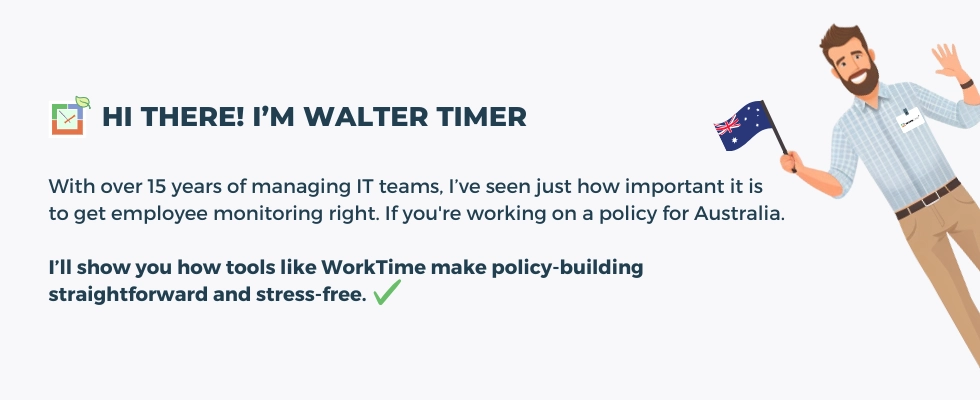
Australian workplace surveillance: legal overview
Employee monitoring policy in Australia is regulated through a combination of federal, state, and territory laws. Despite regional differences, all legislation emphasizes the protection of employee privacy. It’s not just about following the law. It’s about meeting social expectations, too. Let’s explore the core legalities of workplace monitoring and surveillance policy.Federal privacy legislation in Australia
Federal laws in Australia do not regulate workplace surveillance directly. Still, these regulations are applied to how personal information is collected, used, and stored. Here are the main nuances to consider:- The Privacy Act 1988 (Cth) requires compliance with Australian Privacy Principles (APPs);
- Computer and email monitoring should be disclosed in workplace policies and notices;
- Surveillance should relate to business needs;
- Monitoring must avoid highly private areas or personal communications;
- Collected data must be securely stored and used only for legitimate reasons.
NSW, VIC, and ACT workplace surveillance laws
New South Wales, Victoria, and the Australian Capital Territory have specific legislation regulating workplace surveillance:- Workplace Surveillance Act 2005, or Workplace Surveillance Act (NSW);
- Workplace Privacy Act 2011 (ACT);
- Surveillance Devices Act 1999 (VIC).
Other states & territories laws
Queensland, South Australia, Western Australia, Northern Territory, and Tasmania do not have specific employee surveillance legislation. But these states and territories rely on the federal Privacy Act and local surveillance devices laws like workplace surveillance laws (QLD) or the Surveillance Devices Act (WA). We prepared a compliance checklist to meet the main requirements:- ☐ Employee consent is mandatory for surveillance involving video, listening, and tracking devices. In other cases, it is not mandatory but is strongly recommended;
- ☐ Clear notice and monitoring policies are recommended to maintain transparency;
- ☐ Covert surveillance is prohibited;
- ☐ Privacy Act compliance is obligatory if personal data is collected;
- ☐ Employee contracts should reference the policy and include agreement;
- ☐ Recording or monitoring of private spaces or personal communications is banned.
Do I need employee monitoring policy in Australia?
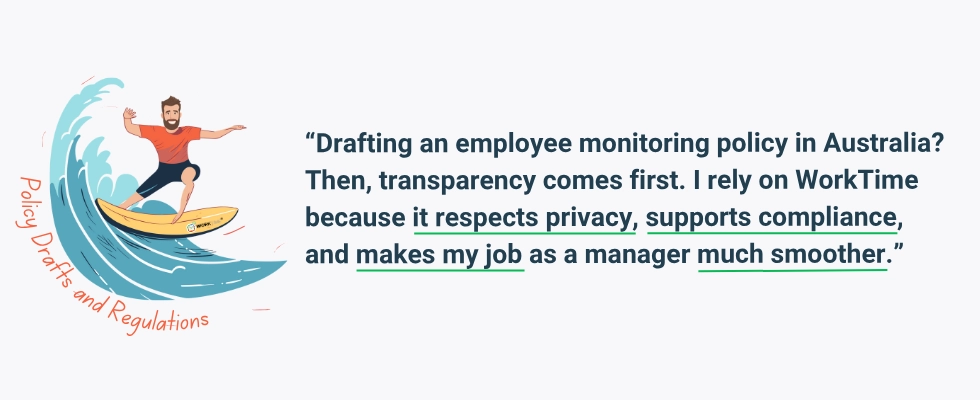
By federal laws - yes
Federal workplace surveillance laws Australia require monitoring policies if your business falls under the Privacy Act and Australian Privacy Principles (APPs). It means that you need to follow these basic requirements:- Have an Australian workplace surveillance policy;
- Notify employees about data collection;
- Explain what data is collected & why;
- Use data only for legitimate purposes;
- Allow employees to access their info.
By state & territory - depends on the state
Workplace surveillance by state and territory has slight differences in regulating monitoring policy. Employee monitoring policy is mandatory in New South Wales (NSW) and the Australian Capital Territory (ACT). There, employers must provide written notice before surveillance begins. In other states and territories (Victoria, Queensland, South Australia, Western Australia, Tasmania, and the Northern Territory), formal policy is strongly recommended. Why is it better to have an employee monitoring policy in Australia? Because it protects both the employer and employees, ensures legal compliance, and promotes transparency in the workplace.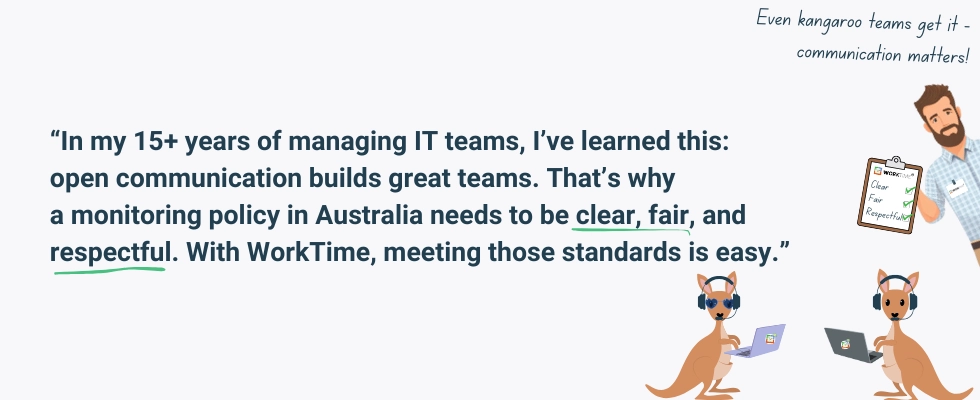
Australian remote monitoring policy: key aspects
Australian workplace surveillance policy for remote workers should consider several nuances.- The expectation of privacy is higher at home. Thus, employee monitoring doesn’t have to invade private life or personal space.
- BYOD policies. Monitoring personal devices is very limited legally and requires clear, specific, and informed consent.
- Monitoring must be reasonable and not intrusive. So, the employer can track only work-related activities or what’s relevant to security.
Is employee consent required in Australia?
Consent - depends on the state, but notice - mandatory
Yes, employee consent is generally required for workplace surveillance and employee monitoring in Australia. Still, the legal standard is slightly different in New South Wales (NSW) and the Australian Capital Territory (ACT). Under the law, employers have to provide written notice at least 14 days before surveillance begins. Thus, obtaining consent is not strictly required, but giving clear and timely notice is mandatory.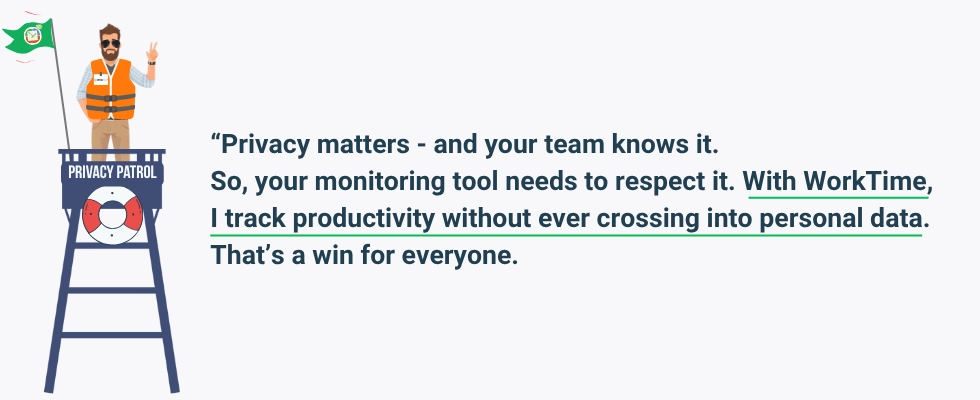
What notice should I use: verbal, written, or electronic?
In Australia, the written notice is the best and most legally compliant form. The electronic notice is also acceptable. What do you need to include?- What is being monitored?
- Why do you implement monitoring?
- How is monitoring data used?
- When you implement employee monitoring software. Australian laws oblige employers to notify employees of the period when monitoring starts;
- Employee rights and contact for concerns.
When to notify employees?
Under most Australian laws, employers must notify employees before implementing employee surveillance in the workplace. In New South Wales (NSW) and the Australian Capital Territory (ACT), employers must provide 14 days’ written notice before surveillance begins.What are the best practices to introduce monitoring policy?
Introducing a computer monitoring policy in Australia requires a balance between ensuring legal compliance, protecting employee privacy, and maximizing productivity. How to make it effectively? Start with transparency and trust. When you clearly explain the monitoring goals and benefits, your employees feel respected and valued. WorkTime aligns perfectly with this approach because it offers a green employee monitoring approach to track productivity without invading privacy. Besides, you can easily craft a transparent employee surveillance policy with WorkTime because- It meets all the legal requirements for monitoring, including privacy regulations, state, and territory surveillance laws;
- It focuses only on work-related activity. WorkTime provides comprehensive productivity insights without micromanaging your team;
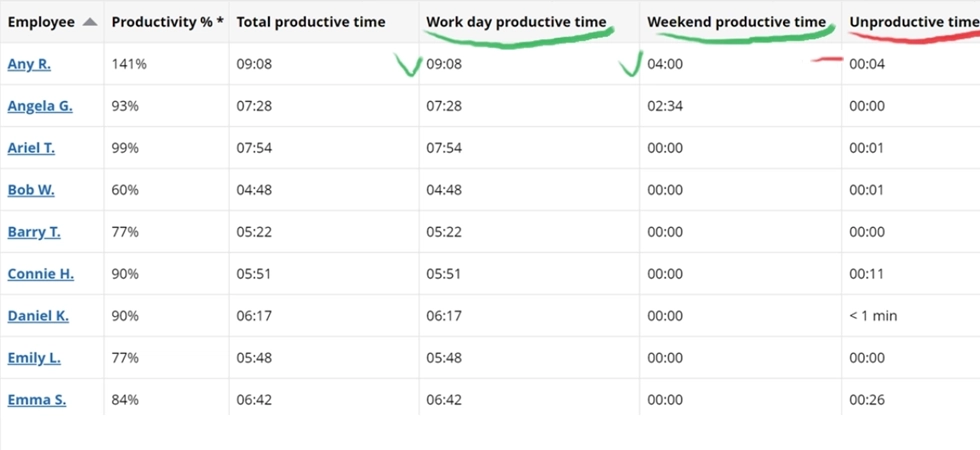

This report provides a brief overview of a particular employee's performance metrics, including productivity, active time, and attendance. It is fully transparent, as it does not capture any sensitive data.
Start free trial- WorkTime monitoring is non-invasive, so your employees feel trusted and valued.
7-step guide to creating Australian monitoring policy
1. Consider the legal framework. Ensure your monitoring policy complies with federal, state, and territory laws. As Australia does not have uniform legislation on workplace surveillance, your policy should cover the regulations where your company/staff is physically located. 2. Define the purpose of monitoring. Australian workplace surveillance policy should explain why you are implementing monitoring. In line with most legal standards, the objectives must be business-driven and supported by reasonable justification. For example, you are implementing monitoring to ensure efficient use of company resources and maintain consistent productivity standards across hybrid or remote work environments. 3. List and explain the monitoring methods. It’s recommended to specify the type, scope, and context of monitoring. This way, you will show that monitoring does not violate employee privacy rights. Australian workplaces require a transparent approach to reduce the risk of legal challenges, improve policy clarity, and reinforce a respectful workplace culture. 4. Draft policy, using clear and accessible language. Australian employee monitoring regulations require employers to craft accessible and understandable policies. It’s better to avoid overusing legal jargon or replace it with clear, plain-English policy language. 5. Notify employees & address employee consent. In several states, including NSW, ACT, and VIC, explicit notification is mandatory. Besides, consent is required depending on the type of monitoring. The best practice is to notify employees and obtain consent to protect your business from penalties, unfair dismissal claims, or privacy complaints.
Get your FREE workplace monitoring policy templates
Simplify your workflow with our free workplace monitoring policy templates, ready to use or customizable to your needs!Australian workplace monitoring policy example
Australian monitoring policy template for remote employees
6-step guide to crafting a clear notice
1. Explain the purpose of monitoring. You need to state why monitoring is necessary. The monitoring goals should be legitimate, reasonable, and business-oriented to follow the privacy legislation in Australia. 2. Specify what will be monitored. Describe in detail the types of monitoring, e.g., internet usage, email communications, or system logs. 3. Define when monitoring will be conducted. Australian privacy principles exist to protect employees from unexpected or intrusive monitoring. It’s important to specify not only “what is monitored” but also “when.” 4. Explain how monitoring data will be used. An employee monitoring policy in Australia should specify:- Who will access the data?
- For what purposes the data may be used (e.g., performance reviews, legal compliance);
- How long data will be stored;
- Whether third parties might access the data.
Get your FREE notice & consent form templates
We’ve prepared a consent form and employee monitoring notice templates that you can tailor to your needs. Simply personalize the templates to suit your business.Employee monitoring notice template in Australia
Australian remote employee monitoring notice template
Privacy consent form template Australia
Australian remote employee consent form template









